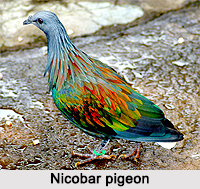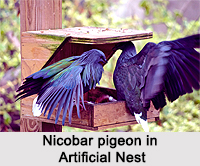 Nicobar Pigeon is an Indian bird that bears a scientific name "Caloenas nicobarica", is a pigeon found on small islands and in coastal regions from the Nicobar Islands, east through the Malay Archipelago, to the Solomons and Palau. It is the only living member of the genus Caloenas and the closest living relative of the extinct Dodo.
Nicobar Pigeon is an Indian bird that bears a scientific name "Caloenas nicobarica", is a pigeon found on small islands and in coastal regions from the Nicobar Islands, east through the Malay Archipelago, to the Solomons and Palau. It is the only living member of the genus Caloenas and the closest living relative of the extinct Dodo.
Structure of Nicobar Pigeon
Nicobar Pigeon is a large pigeon, measuring 40 cm in length. The head is grey, like the upper neck plumage, which turns into green and copper hackles. The tail is very short and pure white. The rest of its plumage is metallic green. The cere of the dark bill forms a small blackish knob; the strong legs and feet are dull red. The irides are dark.
Sexes of Nicobar Pigeon
The female Nicobar Pigeons are slightly smaller than males; they have a smaller bill knob, shorter hackles and browner under parts. Immature birds have a black tail and lack almost all iridescence. There is hardly any variation across the birds` wide range. Even the Palau subspecies C. N. pelewensis has merely shorter neck hackles, but is otherwise almost identical.
Breeding Season of Nicobar Pigeon
The breeding range of Nicobar Pigeon encompasses the Andaman and Nicobar Islands, the Mergui Archipelago of Myanmar, offshore islands of south-western Thailand, Peninsular Malaysia, southern Cambodia and Vietnam, and many of the small islands between Sumatra, the Philippines and the Solomon Islands. On Palau, the only distinct subspecies C. N. pelewensis is found.
Behaviour of Nicobar Pigeon
Nicobar pigeon roams in flocks from island to island, usually sleeping on offshore islets where no predators occur and spends the day in areas with better food availability, not shying away from areas inhabited by humans.
Feeding of Nicobar Pigeon
The food of Nicobar Pigeon consists of seeds, fruit and buds, and it is attracted to areas where grain is available. A gizzard stone helps to grind up hard food items. Its flight is quick, with regular beats and an occasional sharp flick of the wings, as is characteristic of pigeons in general. Unlike other pigeons, groups tend to fly in columns or single file, not in a loose flock.  The White Tail is prominent in flight when seen from behind and may serve as a sort of taillight, keeping flocks together when crossing the sea at dawn or dusk. The young birds` lack of a white tail is a signal of their immaturity clearly visible to con-specifics - to an adult Nicobar Pigeon. It is obvious at a glance which flock members are neither potential mates nor potential competitors or mate are old enough to safely guide a flock from one island to another. This species nests in dense forest on offshore islets, often in large colonies. It builds a loose stick nest in a tree. It lays one elliptical faintly blue-tinged white egg.
The White Tail is prominent in flight when seen from behind and may serve as a sort of taillight, keeping flocks together when crossing the sea at dawn or dusk. The young birds` lack of a white tail is a signal of their immaturity clearly visible to con-specifics - to an adult Nicobar Pigeon. It is obvious at a glance which flock members are neither potential mates nor potential competitors or mate are old enough to safely guide a flock from one island to another. This species nests in dense forest on offshore islets, often in large colonies. It builds a loose stick nest in a tree. It lays one elliptical faintly blue-tinged white egg.
Slaughtering of Nicobar Pigeon
Nicobar Pigeons are hunted in considerable numbers for food, and also for their gizzard stone which is used in jewellery. The species is also trapped for the local pet market.











